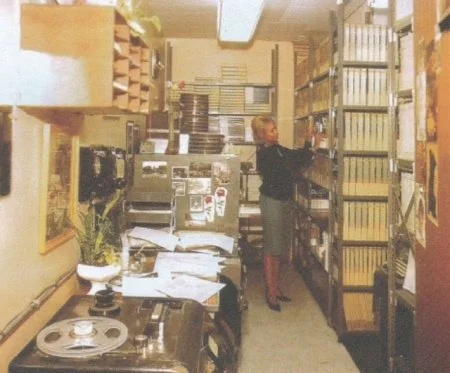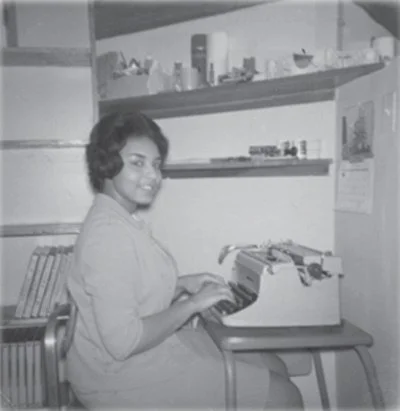The Embrace of Friends
A MAGIC PLACE: MOTOWN’S TAPE LIBRARY
Patricia Cosby was just 18 when she joined Motown Records in Detroit as an assistant in the tape library. “I had no preconceptions,” she says today, “because I had no idea what the tape library was all about – I never imagined there was such a thing as a tape librarian.”
Yet in some respects, that might be regarded as one of the company’s centres of gravity, where the extraordinary music made in the basement studio was stored, catalogued, retrieved, stored again, preserved. “It was like a regular coat closet,” continues Cosby, “and Pops Gordy built it out into an office, and then he built the shelving units. But we could barely turn around in there.”
Honouring Hank: Pat Cosby at the Motown Museum (photo: Brian McCollum)
Who were the “we” who had no room to turn? It was Cosby and her boss, tape librarian Frances Heard, who similarly admitted in her 2010 book, I Remember Motown, that she didn’t know what to expect when she signed on.
Cosby spoke to me in Detroit shortly after the May opening of the Motown Museum’s current exhibit dedicated to her late husband, arranger/writer/producer Henry “Hank” Cosby. “I took a liking to Fran instantly,” she recalls. The job “was just absolutely meant to be, because we still remain friends.” (The next West Grand Blog will be devoted to Hank Cosby’s distinguished career, but here, it’s Pat who is the focus of attention.)
In 1962, Patricia Thompson, daughter of Willie and Meomi Seay Thompson, was fresh out of high school. “Mary Wells was a classmate of mine in both junior high and high school. I ran into her a couple of times at a stretch of about three months apart. She said, ‘What are you doing with yourself?’ And I was taking a couple of classes at Lewis Business School, and job shopping.”
A Top 10 hitmaker by then, Wells suggested that Pat should contact Motown “because they’re going to be hiring secretaries. And I said, ‘What? A little house on the boulevard? You want me to work in a house?’ I didn’t apply.” After the second time she ran into Wells, Cosby spotted a newspaper advertisement for the tape library assistant – and did apply. The interview with Fran Heard went well, and she was hired.
“Our handwriting was so similar,” says Cosby. “[Fran] was recording all this stuff on these cards and in the journal. You have to have legible handwriting, and I’ve always been pretty precise with taking notes and so on. We [also] had a little manual typewriter, then an electric typewriter. That was such an exciting thing!”
Serious Motown fans have long been preoccupied by those card files and that paperwork, of course. “There were codes for each stage of the process of the song. Fran had actually created them all – but I can’t remember what they were, and she can’t either. I apologise.”
Fran Heard in the Hitsville tape library
She also reiterates how much she enjoyed the job. “It was the best experience, because you knew who the producers were, who the arrangers were, you knew the artists, the musicians. The tape library was just across the hall from the studio, so you knew what was going on. It was always exciting for me to know which producer was going into the studio. And we would actually see the call sheet, we knew which musicians were going to be on that session.”
The close proximity of everything and everyone sustained Motown’s family feeling, according to Cosby. “It was very easy for me to make friends. I guess it was the way you were embraced when you started work there. So I was close with a lot of people.” Among them were Deanna Blanks, Sandra Greene, Ardena Johnston – and quality control head, Billie Jean Brown. “We were the best of friends, she and I shared an apartment and, as a matter of fact, it was in a brand new building in Highland Park. That [area] always had a bad name, but this was like a whole new development. Chris Clark was in that building as well.” Still another close friend was Janie Bradford, co-writer of “Money (That’s What I Want),” among other accomplishments. “She always had a naughty sense of humour,” laughs Cosby. “A lot of people were embarrassed by that, but I always thought she was the funniest individual. She could have been Moms Mabley.” And Mr. Gordy’s view? “Oh, he got it – he got it real quick.”
Such close relationships were not restricted to working hours, either. “There was a certain group of us who frequented the race track every day: Janie, Hank, Norman Whitfield, Brian Holland, Eddie Holland, Clay McMurray. We were either going to be at the day races or the night races – the trotters or the thoroughbreds. And we were in the dining room, at the window, at the finish line. People were paying all sorts of money to get those tables, but we had season tables.”
‘THE FIRST STOP AT HITSVILLE’
The tape library was not Cosby’s only assignment. She shared switchboard duties – not least because she had professional training in that skill before joining Motown – or stood in for others, such as Juana Royster. “We became very, very close. She ended up marrying Lawrence Horn. I also got to know the artists really well, being on that switchboard. That’s the first stop you get to when you come into the Hitsville building.”
On another occasion, Cosby was drafted to assist senior executive Ralph Seltzer when the company relocated from West Grand Boulevard into a more conventional office block in downtown Detroit, on Woodward Avenue. “When we moved into the Donovan building,” she remembers, “he had me at his side, doing the floor plans, phone assignments, the size of the room that each producer was going to have. It was kind of chaotic, because you’re going from seven buildings into one structure, but we figured it out. For whatever reason, Ralph relied on my opinion about a lot of things.”
Pat Cosby with that electric typewriter
Cosby assumes that Seltzer has passed on, although confirmation is elusive. “I had two phone numbers for him, but they’re no longer valid,” she says. “He had a vineyard, and at Christmas time, he was always sending us wine. Then the wine stopped. I would love to just say ‘Hello’ to Ralph Seltzer. He meant well, but he was not taken well. But he was doing his job – he was doing what Mr. Gordy told him to do.”
As noted above, Pat Cosby’s ten-year tenure at Motown gave her insights into its creative dynamic, and what happened after the firm’s relocation to Los Angeles in 1972 (she and her husband moved to California, but left some six months later). “One of the reasons that the likes of Hank, Mickey Stevenson and others didn’t fare as well after Motown was because they just didn’t have the freedom that Berry Gordy had given them.
“I’m not saying that Mr. Gordy was perfect, because he was far from perfect, but he did the right thing when it came to the music. He was not a micro manager. A lot of hit records came out of that studio because the producers were given liberty, and they passed that on to their artists, to the musicians.
“It was almost a shame that some of the musicians didn’t get royalties. I witnessed a lot of stuff, and so much of what came out of Motown was because of the collaboration of all of the creators: producers, writers, arrangers, musicians. All of them had input into those hits.”
Evidently, being at the heart of the machine gave Pat Cosby rare insights and engaging memories, not least with husband Hank. But that’s for the next time…
Grateful notes: thanks to John Lester and Drew Schultz for their help with this WGB edition, and, of course, to Patricia Cosby for her time, her wonderful recollections and her patience. More next week, with luck. Also, Bill Dahl’s 2001 book, Motown: The Golden Years, includes first-hand memories from Hank Cosby himself.


